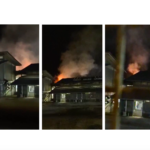The Law, Defences and Penalties for Affray in New South Wales

New South Wales Police are appealing for the public’s help to identify and locate a man they believe may be able to assist in their investigations into a brawl that occurred at a Western Sydney hotel last year.
According to police, at around 7.50pm on Friday, 30th September 2022 emergency services were called to a hotel on Mount Druitt Road in Mount Druitt in response to a melee.
Police from Mouth Druitt Police Area Command attended the premises and, after reviewing footage, arrested and charged three men aged 32, 42 and 45 with the criminal offence of affray in relation the altercation during which a 48-year old woman was allegedly struck in the head with a bar stool as she attempted to leave the venue.
The man police are after is described as of Pacific Islander/Maori appearance, large build, black hair with a rats tail wearing a high visibility fluorescent work shit, blue pants and brown boots.
Each of the men who have been charged remain before the courts.
The offence of affray in New South Wales
Affray is an offence under section 93C of the Crimes Act 1900 which carries a maximum of 10 years in prison.
To establish the offence, the prosecution must prove beyond a reasonable doubt that:
- You threatened unlawful violence towards another person, and
- Your conduct was such that it would cause a reasonable person present at the scene to fear for their safety.
An affray can occur in both public and private places, which means it can happen inside a home or at a privately owned business, as well as on a street, in a public park or anywhere else, and the prosecution does not need to prove that any other person was actually present when the conduct occurred.
The offence cannot, however, be established by the use of words alone.
Table 1 offence
Affray what is known as a ‘Table 1’ offence, which means it will remain in the Local Court unless either the defence or prosecution ‘elects’ (chooses) to have it committed up to the District Court.
Table 1 offences are the second most serious categories of offences in the New South Wales law; the least serious being summary offences (which remain in the Local Court), followed by Table 2 offences (where only the prosecution may elect to have the case committed to a higher court), Table 1 and ‘strictly indictable offences’ (which must be committed to a higher court).
The maximum penalty where the case remains in the Local Court is 2 years in prison.
When does an affray typically apply?
Although there is no legal requirement that another person be actually present for an affray to be established, or for the actions to occur in public, the charge is typically brought in situations such as bar fights, brawls and other altercations where several people are in fact involved but either no one is physically assaulted, or person/s are assaulted but the actions of a person involved were not directly responsible for the assault and did not form part of a ‘common purpose’ to commit the assault.
That said, a person can face both assault and affray charges if police believe on reasonable grounds that he or she was responsible for an assault as well as part of the melee.
Criticisms of the offence
For decades, there has been criticism of the breadth of the legal definition of affray, the high maximum penalty set down and its classification as a Table 1 offence.
The offence was enacted in response to a number of brawls between groups of motorcycle club members in the early 1980s, culminating in the ‘Milperra Bikie Massacre’ of 2nd September 1984.
The primary objective of the offence is deter major public disturbances and punish those involved regardless of whether there is sufficient evidence to prove they were directly involved in a discrete offence, such as an assault or other offence against persons or property.
Breadth of offence
Many believe the offence’s application to both public as well as private areas is unwarranted, given its intention is to cover disturbances in places that are already defined as ‘public’ under the law.
In that regard, the definition of ‘public place’ in New South Wales encompasses publicly as well as privately owned places where members of the public – and even sections of the public – are allowed to enter, such as shopping centres, bars, pubs, clubs, restaurants, shops, car parks and so on. That being the case, there is an argument that it is unnecessary and unwarranted for the offence to apply in the most private of places, such as inside peoples’ homes.
There is also an argument that the fact no other person needs to actually be present for an affray to be established is absurd, given the purpose of the offence is to deter serious public disturbances such as brawls and other melees, and punish those who participate in them.
Indeed, the current law means an affray can technically occur where only the persons involved are present and, taking the offence as defined to its extreme, where a person is recorded threatening unlawful violence in their own home when no one else is actually there, provided there is some physical aspect to their conduct.
In practice, the breadth of the definition consistently results in its misuse by police, with the charge often being ‘slapped on to’ assault charges to ‘see if it sticks’, or brought where there is little to no evidence of a person having been involved in an offence at all.
It is frequently brought in relation to incidents where such a serious charge is not appropriate, and where the Second Reading Speech makes clear parliament did not envision nor intend for it to be brought.
Reform is desperately needed to prevent the situation from continuing.
Excessive maximum penalty
The maximum penalty for being involved in an affray is 10 years in prison; which applies whether or not a person actually commits a physically violent act, or whether anyone is actually hurt by the person or anyone else.
The maximum penalty for a common assault is 2 years in prison. This relates to conduct up to and including the infliction of injuries on another which are ‘transient or trifling’; in other words, that are superficial.
The maximum penalty for an assault which causes actual body harm to another person is 5 years in prison. Actual bodily harm has been found by the courts to include the following factual situations:
- Struck de facto wife. Punched and kicked her on ground dislodging front teeth.
- Punched victim after he refused to give cigarette. Skull and brain damage after hitting ground. Kicked while on ground.
- Assaulted female partner fracturing rib, struck her in head with remote control, punched her to face, grabbed around throat, pushed her, stomped on her legs in presence of children.
- Punched daughter 5 to 6 times in face, pushed her to ground, kicked her to stomach, victim fell on protruding screw causing bleeding to head.
- Punched spouse in eye and pushed against wall. Caused bruising to cheek, eye and back.
- Dragged de facto partner from bed causing her to fall and hit jaw causing bleeding to lip and bruising, hit victim to side of head near eye causing injury, grabbed victim by hair and throat.
- Entered partner’s home and confronted her in bedroom. Hit her to side of head and bit her on ear and face, pushed her to floor and smashed her head against mirror, kicked her in head and knee. unprovoked, sustained and violent attack.
The bottom line is: you can engage in a sustained and brutal physical assault against another person causing them serious injuries and face up to 5 hears in prison, but you will face 10 years if involved in a melee and threaten violence despite not touching let alone injuring anyone, and no one having been hurt.
The situation makes a mockery of the law.
Classification of offence
Equally nonsensical is the classification of affray as a Table 1 offence (the second most serious category of offence in New South Wales) where the offence of common assault is classified as a summary offence (the least serious offence type) and assault occasioning actual bodily harm as a Table 2 offence (the second least serious category).
What penalties are actually handed down by the courts for affray?
The Judicial Commission of New South Wales publishes statistics on the penalties handed down by the courts for affray.
According to the Commission, the penalties imposed for cases that came before the courts can be broken down as follows:
Where case finalised in Local Court: 4,685 cases
| Penalty type | Number of cases | Percentage of cases |
| Community correction order (with criminal conviction) | 1972 | 42.1% |
| Intensive correction order (with criminal conviction) | 618 | 13.2% |
| Fine (with criminal conviction) | 605 | 12.9% |
| Imprisonment (with criminal conviction) | 593 | 12.7% |
| Conditional release order without criminal conviction | 591 | 12.6% |
| Conditional release order with criminal conviction | 250 | 5.3% |
| Section 10(1)(a) dismissal (no criminal conviction) | 39 | 0.8% |
| Section 10A (with criminal conviction) | 17 | 0.4% |
Where case finalised in District Court: 55 cases
| Penalty type | Number of cases | Percentage of cases |
| Imprisonment (with criminal conviction) | 29 | 52.7% |
| Community correction order (with criminal conviction) | 14 | 25.5% |
| Intensive correction order (with criminal conviction) | 6 | 10.9% |
| Conditional release order without criminal conviction | 3 | 5.5% |
| Conditional release order with criminal conviction | 2 | 3.6% |
| Section 10(1)(a) dismissal (no criminal conviction) | 1 | 1.8% |
What are the defences to affray charges?
If you are able to raise evidence of a legal defence to affray, the onus then shifts to the prosecution who must establish beyond a reasonable doubt that the defence does not apply in your case.
If the prosecution is unable to do this, you are entitled to an ‘acquittal’; in other words, a verdict of not guilty.
Legal defences to affray charges include:
- Self-defence – which is where you believed your actions were necessary to defend yourself or another person, or to prevent the unlawful deprivation of your liberty or that of another person, or to protect your property from being taken, destroyed, damaged or interfered with, or to prevent criminal trespass to your land, or remove a person criminally trespassing, and your conduct was a reasonable response to the circumstances as you perceived them at the time.
- Duress – which is where your conduct arose due to an imminent threat made to you or someone close to you, in circumstances where the threat was continuing and serious enough to justify your actions, and
- Necessity -which is where you engaged in your actions to avoid serious, irreversible consequences to you or someone you were bound to protect, you honestly and reasonably believed you or the other person were immediate danger and your actions were a reasonable and proportionate response to the danger.
Going to court for affray?
If you are going to court for affray, call Sydney Criminal Lawyers or (02) 9261 8881 to arrange a free first conference with a criminal defence lawyer who is vastly experienced in defending and winning these cases.
We will accurately advise you of how the law applies in your specific situation, your options and the best way forward, and will fight to achieve the optimal result in your case, so you can get on with your life.






